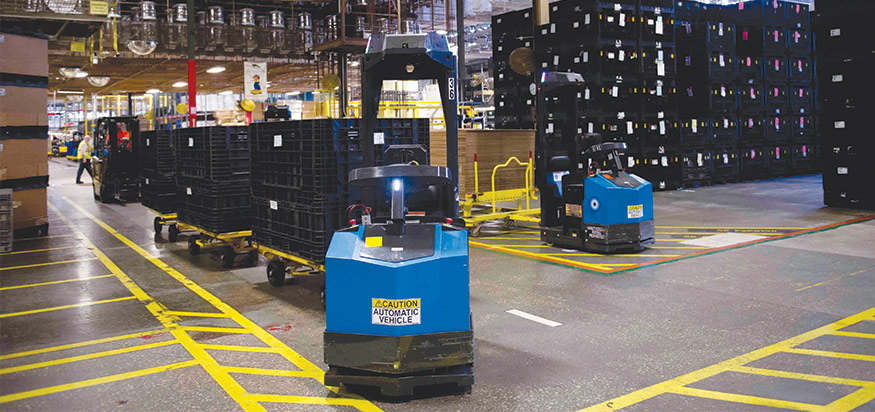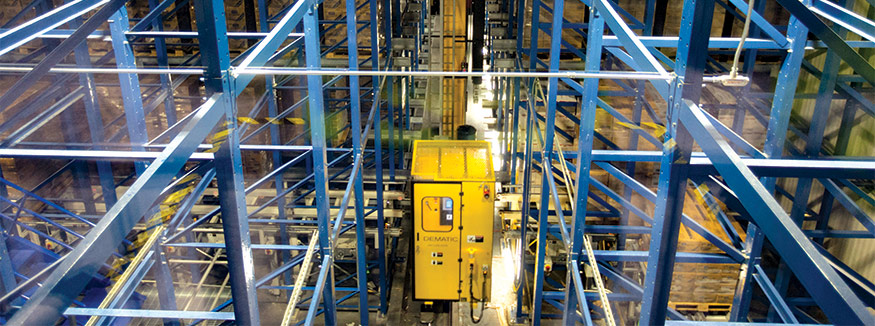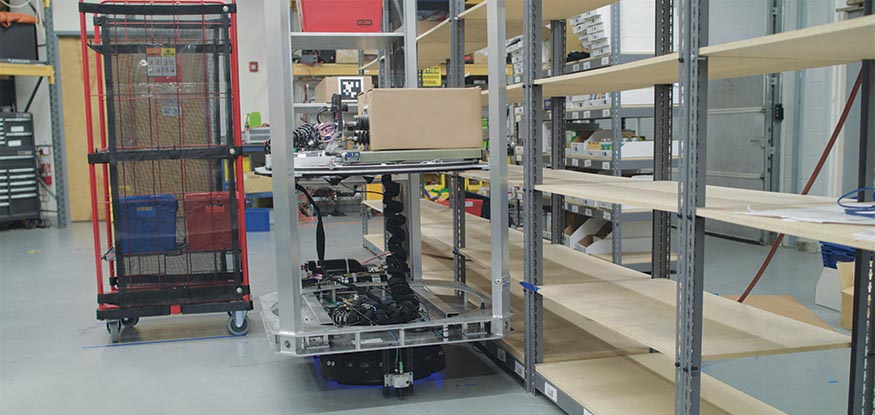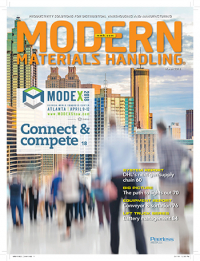Big Picture: On the path to lights out
There may not be many plants and warehouses operating in the dark these days. However, many facilities are clearly on the path to lights out, balancing automation and labor to find the right mix of lower costs and better customer service.
Neither the concept nor the existence of a lights-out plant or warehouse is new. But let’s face it, these facilities are still few and far between.
That doesn’t mean lights out is not a good idea. It is. But rather than focusing on dark facilities, the story now is about the path to lights out. And that path goes right through the world of automation.
Industry experts say that few companies start out asking for a lights-out facility design. But they are all clearly interested in using automation as extensively as possible.
Customer demands for better-faster-cheaper along with rising labor costs and low availability are powerful motivators here. That puts the spotlight squarely on automation for a broad range of industry sectors. Furthermore, the new tax laws are making it easier to justify automation now than it was a few months ago.
So, the lamp is still lit for lights out. But it does shine differently in 2018 than it did some time ago.
What is lights out today?
Historically, the working definition of lights out is a facility without people. Zip. Zero. Nada.
But “lights out no longer literally means lights out,” says Jeff Christensen, vice president of product at Seegrid. “Lights out is now a North Star metaphor for extensive use of automation, not a tangible deliverable in and of itself,” he adds.
Christensen goes so far as to say that he doesn’t recommend a dark facility without human workers because the business case just isn’t there. Instead, companies should make it a goal to automate 80% of their materials handling operations in the near future and up to 95% eventually. The last 5% is just not financially worth it, he says.
Simon Drexler, director of product at Otto Motors, says “if you can get to 80% lights out, you are doing phenomenally.” That said, others put the percentage even lower.
Most experts now look at facilities in terms of functional activities and the opportunity to run lights out only in certain areas of the facility.
“What matters today in the lights-out story is making it happen in all functional areas possible. Not everywhere,” says Mike Khodl, Dematic’s vice president of global solutions management.
Beyond that, there are a few types of facilities where lights out has much more than casual cache.
The long-time leader remains freezer and even refrigerated facilities. These environments are as inhospitable as can be and removing people from them is a common objective.
Grocers as well as health and beauty retailers are also high on the list. That’s according to Brian Sherman, vice president of sales and engineering, North America, at Witron, which has supplied nearly lights-out facilities to many of those companies.
There is also enormous interest among e-commerce fulfillment centers. “There isn’t a major retailer with e-commerce operations that isn’t interested in lights out to some degree,” explains Bryan Jensen, chairman and executive vice president at consultant St. Onge Co.
The level of importance of lights out can be gauged by the number of NDAs (non-disclosure agreements) out there. No retailer wants its consultants or suppliers to talk about their plans. There’s just too much on the line especially in regard to order picking, the weak link in a true, lights-out scenario.
Ultimately, the big picture of lights out today is to have machines do the handling and people do the creative thinking whenever possible, says Tom Galluzzo, CEO of IAM Robotics. And, that’s not a bad starting point.
It’s important to note that there is most likely a long timeline for the path to lights out. It’s often part of a five- to 10-year plan, says Laura McConney, marketing specialist at JBT. In other words, the path to lights out has an extended trajectory, and with good reason.
Balancing labor and automation
Lights out is now a boardroom topic not a cost-center discussion, says John A. White III, president and CEO at Fortna, an engineering and consulting firm. The trick is to determine where the fulcrum fits in the seesaw balancing labor and automation.
Leading issues with labor in the United States, says White, are
- cost,
- availability,
- turnover,
- retraining, and
- demand spikes.
White says major drivers of automation are
- better service,
- faster order fulfillment, and
- horter order cycle times.
“There’s more automation in Europe than the United States, and more in the United States than in China,” explains Jensen. “The balance between labor and automation is a function of the availability and cost of labor in relation to the cost and sophistication of automation,” he adds.

Work-in-process transportation such as these tuggers at Whirlpool is often a target for lights-out operation.
Return-on-investment (ROI) figures prominently here, too. Most companies look for a three-year return. Some extend it to five years.
“The lights-out model has a longer time frame,” says David Huff, principal technology consultant at Honeywell Intelligrated. Both he and others suggest that a more realistic window is seven to 10 years. That’s not an easy hurdle for many companies.
But the new tax law may help. “New tax rules are hastening automation and modernizing U.S. factories by giving manufacturers an incentive to buy machinery and boost productivity in a tight labor market,” said The Wall Street Journal on January 26 of this year.
The Journal went on to cite several companies already taking advantage of the new ability to deduct all equipment cost immediately rather than spreading it over five years. And automation figures in those companies’ equipment purchases time and again. In fact, one of the photos in the article was of an automated warehouse from Witron at Festo, a manufacturer of factory automation solutions.
That tax shift may help justify automation for lights out, but the seven- to 10-year timeframe is still too long for many companies. That’s a major factor changing the traditional definition of lights out.
Lights out where possible
Use of lights out on a spot basis is a prominent part of discussions today, says Khodl of Dematic. “The question is: How can we make a functional area as lights out as possible?” he says.
An example is the automated storage and retrieval system that Dematic installed for Preferred Freezer Services in Richland, Wash. This is the largest automated freezer warehouse in North America with 120,000 pallet positions. Lights-out storage is in three freezers handling two billion pounds of French fries annually.
Storage of all types is just one functional area that lights out is a natural. Goods-to-person transportation routes using conveyors, automatic guided vehicles and autonomous mobile robots are also high on the list.
One solution that brings together storage, transportation and pallet building is from Witron. The company has 57 nearly lights-out handling systems installed worldwide. These systems manufacture store-ready pallets for retailers including Kroger, Supervalu, Target, Sobeys and Meijer, says Witron’s Sherman. He explains that these systems do not operate like a typical warehouse. Instead, they are “a manufacturing system with an output of pallets.”

Automated storage and retrieval systems operate lights out in Inhospitable freezer operations at Preferred Freezer Services.
The story in picking
Order picking is the biggest challenge on the path to lights out. There, people still figure prominently in the cost analysis. “In these labor-intensive operations, people are still more affordable than automation,” adds Jensen.
In fact, most experts maintain that robots and other forms of automation will continue to work together with people in picking and elsewhere for the foreseeable future.
Jeff Burnstein, president of the Association for Advancing Automation, agrees. Robot unit sales have been growing at a 15% annual rate for some time and are expected to continue for the next couple of years. Driving that growth are materials handling robots of all types, Burnstein adds.
That said, robotic handling technology does not have all the answers. In fact, the challenge is considerable.
To begin, items come in different sizes and shapes. In addition, the equipment needs to know what to pick, how many, and how to pick them. Finally, you need to know what the equipment will do with the item once it’s picked.
This is one place where what people can do naturally is far ahead of what automation can do. “We are only 40% to 60% of getting robots to lights out in many functions,” says Dematic’s Khodl.
Galluzzo of IAM Robotics explains. “Robots, as well as other automated equipment, are force multipliers. But robots can’t think outside of the box. They can’t think creatively, yet. We’re on the path with artificial intelligence, but certainly aren’t there yet.”
An example of that evolution is an installation IAM Robotics did at Rochester Drug. While not a lights-out operation, it is an early step in robots thinking more creatively, putting them on the path to lights out.
At Rochester, a mobile piece-picking robot picks from 3,000 SKUs (it started with only 1,200) stored on static shelves in a four-aisle pick zone. It travels autonomously to a location and uses an arm with a suction cup to pick designated items into a tote. The robot then travels autonomously to a designated drop off location.
The robot can pick at the same rate as humans with at least equal accuracy. It’s worth noting that humans monitor the robot’s activities daily.
Similar ground-breaking developments are underway elsewhere as suppliers move down the path to lights out. Last year, the DHL and Dell Robotics Mobile Picking Challenge awarded first place to Vecna Robotics, says John Hayes, vice president of sales and marketing.
The challenge required a robot to navigate a warehouse and pick boxes and totes from shelves. Vecna’s entry picked the boxes from different shelf levels and placed them on an autonomous mobile robot. Although lights out was not part of the challenge, the Vecna solution is clearly on the path to lights out, says Hayes.
Other challenges lie beyond the technology. Huff at Honeywell Intelligrated calls it “the Hollywood syndrome. Practitioners have very high expectations for the capabilities of automation. Much like what they see in the movies. And that means they over shoot,” he says.
In some ways, this smacks of the eighties and nineties. Those were the days when so many CEOs had to have at least one robot out on the floor regardless of the equipment’s usefulness for the job at hand.
As attractive as lights out is conceptually, it has to be the right solution. And sometimes an interim solution is the right one, explains Drexler of Otto Motors. An installation his company did at Hirotec America is an example of a partial lights-out solution that uses available technology suited to the job at hand.

Robotic item picking is high on the list of aspiring lights-out operations. This developmental mobile robot from Vecna Robotics won the DHL & Dell Robotics Picking Challenge last year for its ability to pick boxes and totes from shelves.
An autonomous mobile robot with an arm-piece picking robot automates one phase of the handling and delivery process for spare parts at the company. But it can’t do everything the company wants it to do quite yet. However, Hirotec has plans for making this a dark operation in the future as the automation develops.
What’s the timeline?
So, exactly how long is the path to lights out on a broad scale in the United States? That’s a good question.
Responses from the experts we interviewed ranged from five years to 30. That’s quite a range. Part of the challenge is defining what exactly is meant by lights out as is evident from this article.
The advancement rate of the many technologies involved is a challenge. And, don’t forget the cost and availability of labor. Then there’s the matter of adoption not to mention cost justification. Right now, lights out is a path less traveled. But don’t expect that to be the case much longer.

Article Topics
Automation News & Resources
Walmart chooses Swisslog AS/RS and software for third milk processing facility Lucas Watson appointed CSO for Körber’s Parcel Logistics business in North America 60 Seconds with Bob Trebilcock, outgoing executive editor, Modern Materials Handling Kathleen Phelps to join FORTNA as chief financial officer Coles automates grocery distribution in Australia 2024 Intralogistics Robotics Survey: Robot demand surges Warehouse automation extends life of cheese DC by a decade More AutomationLatest in Materials Handling
Registration open for Pack Expo International 2024 Walmart chooses Swisslog AS/RS and software for third milk processing facility NetLogistik partners with Vuzix subsidiary Moviynt to offer mobility solutions for warehouses Materials Handling Robotics: The new world of heterogeneous robotic integration BSLBATT is looking for new distributors and resellers worldwide Lucas Watson appointed CSO for Körber’s Parcel Logistics business in North America Hyster recognizes Dealers of Distinction for 2023 More Materials HandlingSubscribe to Materials Handling Magazine

Find out what the world's most innovative companies are doing to improve productivity in their plants and distribution centers.
Start your FREE subscription today.
April 2024 Modern Materials Handling

Latest Resources












